A Geo-Environmental Analysis of the Groundwater Resource vis-a-vis Surface Water Scenario in Guwahati City
Neelkamal Das1 and Dulal C. Goswami1
1
Department of Environmental Science,
Gauhati University,
Guwahati,
781014
India
DOI: http://dx.doi.org/10.12944/CWE.8.2.13
Copy the following to cite this article:
Das N, Goswami D. C. A Geo-Environmental Analysis of the Groundwater Resource vis-a-vis Surface Water Scenario in Guwahati City. Curr World Environ 2013;8(2) DOI:http://dx.doi.org/10.12944/CWE.8.2.13
Copy the following to cite this URL:
Das N, Goswami D. C. A Geo-Environmental Analysis of the Groundwater Resource vis-a-vis Surface Water Scenario in Guwahati City. Curr World Environ 2013;8(2). Curr World Environ 2013;8(2). Available from: http://www.cwejournal.org/?p=4471
Download article (pdf) Citation Manager Publish History
Select type of program for download
| Endnote EndNote format (Mac & Win) | |
| Reference Manager Ris format (Win only) | |
| Procite Ris format (Win only) | |
| Medlars Format | |
| RefWorks Format RefWorks format (Mac & Win) | |
| BibTex Format BibTex format (Mac & Win) |
Article Publishing History
| Received: | 2013-06-03 |
|---|---|
| Accepted: | 2013-07-17 |
Groundwater constitutes about 20 percent of the world's fresh water supply, which is approximately 0.61% of the entire world's water, including oceans and permanent ice. Global groundwater storage is roughly equal to the total amount of freshwater stored in the snow and ice caps, including the north and south poles. In India more than 90% of the rural population and nearly 30% of the urban population depend on groundwater for drinking purpose (NRSA, 2008). Groundwater is replenished naturally by surface water from precipitation, streams and rivers. However, unplanned urbanisation coupled with rapid population growth has started exerting tremendous pressure both on the surface and sub-surface water resources. Unprecedented population growth affects the hydrological cycle resulting in less subsurface infiltration rate and higher volume of surface water run-off (Schueler, 1987; Ferguson, 1994). The city of Guwahati, in spite of being located on the bank of the mighty Brahmaputra, depends heavily on the groundwater resource for its water requirements. About 69.90% of the households in the city use groundwater, while 27% depend on piped water supply and the rest on surface water obtained mainly from streams (Goswami et al., 2005). But since the last few years due to excessive growth of population and the subsequent overexploitation of groundwater, the water table in many parts of the city has been showing a declining trend. Guwahati city, the gateway of North East India is located in the Kamrup (Metropolitan) district. It is bounded by 26°05' N to 26°12' N latitudes and 91°34' E to 91°51' E longitudes. Situated on the southern bank of the river Brahmaputra, the Guwahati Municipal Corporation (GMC) area covers an area of about 216 sq. kms. The city presents an undulating topography, dotted with nineteen low lying hills interspersed with elongated valley fills. The southern and the eastern sides of the city are bounded by rows of hills which are extensions of the Khasi Hills of Meghalaya (Pathak, 2001). Geologically, Guwahati rests upon the typical Precambrian rock units which are overlain by young and recent alluvium. The river Bharalu dissects the main city for a length of about 9 kms (Barman, 1993). Small rivulets like Panchadhara, Kalmoni and Khonanadi flow through the fringe zone of the city in the south and south-west. It is worth mentioning that about 61.8% of the total area of the city is covered by hills, water bodies and pockets of low lying areas (Borah and Saikia, 1998). The city is located at an elevation of about 54 metres above mean sea level. The location map of Guwahati city with its Municipal ward boundaries is shown in figure 1.
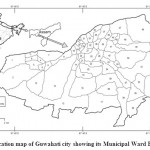 |
Figure 1: Location map of Guwahati city showing its Municipal Ward Boundaries Click here to View figure |
Material and Methods
The methodology applied in this study involves both empirical analysis and field surveys. Data for the study were collected from both primary and secondary sources. Primary data on various parameters pertaining to the study area based on field surveys using a questionnaire specially designed for the purpose and making field measurements on selected geohydrological parameters like ground water level in wells, volume of surface water bodies, etc., have been collected from the field, satellite imagery, Survey of India topographical sheets, geocoded False Colour Composite (FCC) and black and white paper prints. The scale used for the Primary data extraction was 1:25000. The secondary data source comprises maps, statistics, published research papers, journals, satellite imagery, etc. These secondary data were mainly collected from various organisations and departments such as Central Groundwater Board (CGWB), Assam Remote Sensing Application Centre (ARSAC), Regional Meteorological Centre, National Institute of Hydrology (NIH), Directorate of Geology and Mining (DGM), etc. The Survey of India (SOI) topographical sheets no 78 N/12, 78 N/16 on 1: 50,000 scale were used to prepare the base map and to acquire various information about the area. Though the SOI topographical sheet is in 1:50,000 scale, the required portion is enlarged upto 1:25,000 scale. All the thematic details were transferred to the base map from SOI topographical sheet. Preliminary interpretation from the satellite imagery was done and landuse / landcover map and geomorphological were drawn from the imagery. The IRS imagery of 2006 on 1:50,000 scale was also used. In addition to these the hydrogeomorphological map, groundwater potential map and panel diagram of the study area were procured from various relevant organisations. The maps were then analysed and integrated using GIS techniques. To acquire the groundwater level in different parts of the study area, water levels of dug wells were also taken.
Results and Discussion
At present in Guwahati, the Guwahati Municipal Corporation (GMC), Public Health Engineering Department (PHED) and Assam Urban Water Supply and Sewerage Board (AUWSSB) are primarily involved in distribution of domestic water supply mainly drawn from the Brahmaputra River. However, the water supplied by these agencies is able to meet the demands of just about 30 % of the city’s population. The total installed capacity of potable water generation under GMC area is around 98 MLD (Million Litre per Day) while the requirement is as much as 132 MLD. The projected water demand in the existing Guwahati Municipal Area is further expected to grow to the tune of 425 MLD by the year 2025 (GMDA, 2009). Although the Brahmaputra can fulfill the water demand of all the inhabitants of this city, yet it seems that due to unorganised planning and inadequate infrastructural development of treatment plants over the years, major part of the city’s population has to depend on groundwater to meet their demands. Moreover, distribution and development of the aquifers are not uniform in Guwahati and often during dry season the hand pumps and deep tube wells in many parts of the city go dry leading to acute scarcity of groundwater.
Surface Water Scenario of the Study Area
The existing natural drainage of Guwahati comprises the Brahmaputra and its minor tributaries such as the Bharalu, Mora Bharalu, Khanajan, Basistha and Bondajan. The Brahmaputra which flows in an east-west direction along the northern fringe of Guwahati is only 1.5 km wide near the city. In addition to the above mentioned tributaries, Digaru, Bonda, Amcheng, Barapani are some of the other major streams that flow through the city. The Digaru along with other tributaries like Bonda and Amcheng form small plains in between the hill ranges in the east and south-eastern part of the city. The three tributary basins of Guwahati, viz. the Bondajan basin, the Bharalu basin and the Khanajan basin have contrasting characters with a 9 degree, 6 degree and 3 degree slope respectively. This shows that the average slope of the study area falls while transversing from the eastern part to the western part, with exception of inter-basin separation. The Khanajan in the western most part of the city links Deepor Beel (wetland) with the Brahmaputra. Mora Bharalu is a small channel which is linked with Bharalu and Basistha stream in south and south-eastern part of the city and flows to the Deepor Beel. The city of Guwahati is dotted with numerous surface water bodies comprising of wetlands and ponds. These water bodies play a significant role in holding rainwater for considerable period of time and serve as reservoirs. But unprecedented urbanisation and development activities have reduced these water bodies to fragmented forms. At present, the city can boast of only six wetlands, viz., the Deepor beel, Hahsora beel, Silsako beel, Narengi beel, Borsola and Sarusola beel. The Deepor beel which is situated in the western part of the city is the largest amongst them and is also a Ramsar site. The Borsola and Sarusola beels are located in the central part, while the Hahsora, Narengi and Silsako beels are located in the eastern part of the city. Apart from the various natural water bodies, there are a number of historic water tanks or ponds within the city. These tanks which include Dighalipukhuri, Silpukhuri, Joorpukhuri, Nagputapukhuri, Kamakhyapukhuri, etc. play a critical role in maintaining surface water repositories of the city. These surface water bodies sustain water flow dynamics between the high land and low land of the city’s landscape, function as storm water reservoir and act as potential sites for natural recharge of the sub surface water. The distribution of the surface water sources, however, is not uniform throughout the city and is controlled by the landscape patterns along with the rivers and streams which originate from the southern and north eastern highlands and flow along the natural slope gradient of the city. Wetlands are located in the central, south eastern and western parts of the city. These parts are primarily depressed valley areas with remnants of palaeo-channels of Brahmaputra being traced through various studies and surveys. From figure 2, it is observed that natural drainage exists in atleast 30 wards of the city with the highest density of about 26 sq. kms. in ward number 46.
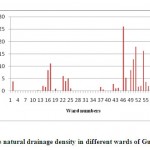 |
Figure 2: The natural drainage density in different wards of Guwahati city Click here to View figure |
Moreover, it is evident from figure 3 that atleast 8 wards of the city viz, 1, 2, 13, 37, 46, 47, 51 and 52 have more than 5 sq. kms. of its area under wetlands and these wetlands facilitate in maintaining the moisture content of soil in its vicinity and also in elevating the water table of the surrounding area.
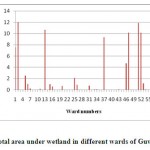 |
Figure 3: Total area under wetland in different wards of Guwahati city Click here to View figure |
Rainfall Regime of the Study Area
Rainfall is highly seasonal in Guwahati and it falls under the regime of the south-west monsoon. The city experiences an average annual rainfall of about 162 cm, which is considerably less than the average annual rainfall of about 220 cm for the state of Assam as a whole. The average number of rainy days per year in the city is about 110 days. The average mean rainfall in the study area is shown in the form of bar diagram in figure 4.
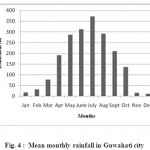 |
Figure 4: Mean monthly rainfall in Guwahati city Click here to View figure |
In the study area, the maximum rainfall occurs during the monsoon period and the minimum during post-monsoon period, as evident from figure 5. Some of the dug wells dry up during the lean period (post-monsoon and pre-monsoon) of the year as the groundwater draft exceeds recharge of the underground aquifers. This is mainly because there are no structures to intercept and retain the excess rainfall that occurs during the monsoon period and huge amount of rainwater is lost as run off. It therefore becomes imperative that long-term measures be taken to entrap and retain rainwater during the monsoon period in utilise them in the lean periods.
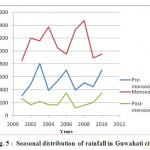 |
Figure 5: Seasonal distribution of rainfall in Guwahati city Click here to View figure |
Groundwater Scenario of the Study Area
The occurrence and movement of ground water is influenced by lithology, structure, geomorphology and drainage pattern of a particular area while replenishment or recharge is further affected by landuse, precipitation and infiltration rate. The ground water level in the study area varies according to local topographic conditions. In areas close to the undulating inselbergs / residual hills viz. Basistha, Borbari, Panjabari, Mathgharia, Birubari area the water level is deeper compared to the areas situated in relatively flat alluvial plains and valley-fill areas such as Rukminigaon, Wireless, Kacharibasti, Gotanagar, Jalukbari areas. In valley-fill areas depth to water level is variable depending on thickness of the residuum. Overall depth to water level gradually reduces from elevated eastern and south-eastern areas to the flat lying alluvial plains in the west. However, the depth to water level in areas like Rehabari, Nepali Mandir, Paltanbazar area is found to be deep though these are situated on valley-fill deposits. This may be due to high amount of groundwater withdrawal in the area for both domestic and commercial purposes. Geological structures may act either as conduits or barriers to the flow of groundwater. Lineaments representing faults, fractures, shear zones, etc. are the structural features that control the occurrence and movement of groundwater in hard rock terrain (Subramanian and Seshadri, 2010). In the eastern part of the study area there is a fault trending NNE-SSW which gives rise to the formation of Silsako and Hahchora beels. Another prominent fault is seen in the central part of the study area trending along NNE-SSW direction. This lies in the corridor between the Fatasil hills and the Narakasur hills. These faults are overlain by weathered rocks or alluvial plain. This zone, which includes areas such as Garchuk, Betkuchi, Fatasil-Ambari, Birkuchi, the Silsako and Hahchora beels has negligible thickness of clay layer in their soil profile, while the thickness of the sandy layer varies from 50-60 metres, thus resulting in easy and convenient infiltration of surface water through them. The groundwater potential zones of the study area are shown in figure 6.
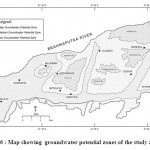 |
Figure 6: Map showing groundwater potential zones of the study area Click here to View figure |
Hydrogeological studies revealed the presence of groundwater just under water table conditions in case of shallow aquifers; however, in case of deeper aquifers it is available within the semi-confined to confined conditions. In the loose unconsolidated formations depth to water in the open dug wells ranges from 2 to 4 metres below ground level during pre-monsoon period. Dug wells located in the foothills zone however show deeper ground water level ranging between 5 to 10 metres below ground level during pre-monsoon period. Shallow tube wells constructed in the loose formation down to 30 metres by Public Health Engineering Department yield around 2000 to 3000 litres per hour and the well yield shows consistent behaviour throughout the year. Normal dug wells constructed in the pediment formation covering the valley parts of the city down to maximum depth of 15 metres store good quantity of water irrespective of seasonal change and can be pumped at the rate of 10 cu.m/day. However, normal dug wells constructed in the weathered formation of the hill areas down to maximum depth of 25 metres having water level around 5 to 7 metres during monsoon period and more than 10 metres during lean period show erratic behaviour of storage depending upon the structural pattern of the rock and seasonal rainfall. Deep tube wells constructed in the valley portion down to maximum depth of 200 metres in the western parts of the city show very good discharge of about 70 to 100 cu.m/hr. for nominal drawdown. In the central part of the city, deep tube wells down to maximum depth of 100 meters give yield upto 80 cu.m/hr. Near hillocks of the eastern and southern parts of the city, the discharge of deep tube wells down to maximum depth of 80 metres give yield upto 30 cu.m/hr for considerable drawdown. The hard rocks found in these hillocks are also potential sites for construction of bore wells. Bore wells constructed down to maximum depth of 200 metres in the hard rocks have been found to be effective for groundwater development. Fractures, fissures, joints developed during tectonic events acts as good water repository in these hard rocks. Maximum yield of such wells particularly in the Beltola and Odalbakra areas reveal that water can be drawn at the rate of 80 cu.m/hr for six to eight hours daily. As per hydrogeological studies conducted by the Central Ground Water Board during 2004 – 2006, the net annual dynamic groundwater availability in Guwahati has been estimated to be in the tune of 11045.31 Ha-m or 11 mcm with a static ground water resource of 625152 Ha-m or 625 mcm, up to the depth of 200 metres. The current annual gross groundwater draft for all uses has been estimated to be around 2806 Ha-m. Based on the long term groundwater trend for a minimum period of 10 years, the stage of groundwater development (in %) can be expressed as,
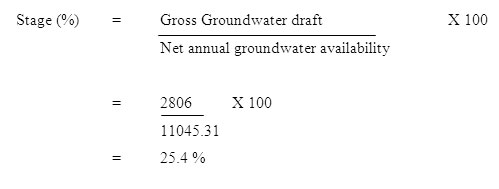
Although this indicates the presence of ample groundwater resource and the stage of development is also within manageable proportions, it should however be taken into consideration that the utilisation of groundwater resource should be done in a scientific and systematic manner, with due emphasis on the prevailing hydrogeological conditions of the area. Groundwater development and management is the key for sustainable upliftment of a particular area and proper management practices will ensure effective utilisation of this valuable natural resource. It is imperative that designing of wells should be based on the aquifer characteristics, hydrogeologocal setup and water requirement. The ever increasing rate of population growth coupled with an expanding urban sprawl have resulted in overdependence on groundwater for meeting the daily water requirements of a major chunk of the city population. This has led to a rapid depletion of water table due to over-exploitation of groundwater in recent years. The irony of the situation is that inspite of being located on the bank of one of the world’s largest rivers – the Brahmaputra, most of the inhabitants of Guwahati city face the problem of acute shortage of water. The rolling topography of the city marked by several hills and hillocks provides a perfect setting for locating large-size storage reservoirs and tanks which can serve different parts of the city through a well organised network of water distribution system. Further, it is recommended that the general public, non-governmental organisations and the concerned government authorities should play a proactive role in this regard and take certain initiatives, such as, (I) Delineation of potential recharge zones and formulation of appropriate plans and programmes to preserve these zones and to revive and reclaim the areas which have deteriorated during the course of the time. (II) Awareness should be created among the general public by different public and non-governmental organisations about the importance of such recharge zones for increasing the availability of water and safeguarding the environmental quality of the region. (III) Stern regulatory and authoritative steps should be taken by the concerned Governmental agencies and departments to stop the encroachment of the potential recharge zones into built-up areas.
Acknowledgement
The authors acknowledge the help of the scientists, academicians and officials of the various institutions and organisations, particularly, Central Groundwater Board (CGWB) NE region, Assam Remote Sensing Application Centre (ARSAC), Regional Meteorological Centre, National Institute of Hydrology (NIH), Directorate of Geology and Mining (DGM) for their cooperation and assistance during the course of this work.
References
- Barman D. K., Remote sensing contribution for augmentation of urban water supply in Greater Guwahati area, National Symp. on Remote Sensing Applications for Resource management with special emphasis on NE Region, 490-496 (1993).
- Borah P. and Saikia R., A Geomorphological study of water logging problem in Guwahati City, Assam, Proceedings of NAGI’s (NE Region) National Conf. on Environment & Sustainable Development, 258-265 (1998).
- Ferguson B. K., Storm Water Infiltration, Lewis Publishers, CRC Press Inc., Boca Raton, Florida, (1994).
- GMDA, Master Plan for Guwahati Metropolitan Area – 2025, Part-I, 141(2009).
- Goswami D. C., Kalita N. R. and Kalita S., Pattern of Availability and Use of Domestic Water in Guwahati city, Symposium on 150 years of Guwahati under Public Administration – A critical assessment of its Development, 71-80 (2005).
- NRSA, Govt. of India, Ground Water Prospect Mapping for Rajib Gandhi National Drinking Water Mission, 256 (2008).
- Pathak B., Study of some geophysical properties of the basement and its overlying sediments of the Greater Guwahati area, district Kamrup, Assam, Unpublished Doctoral Thesis, Gauhati University, (2001).
- Schueler T. R., Controlling Urban Runoff : A practical Manual for Planning and Designing Urban BMPs, Department of Environmental Programs, Metropolitan Washington Council of Govt., Water Resources Planning Board, (1987).
- Subramanian S. K. and Seshadri K., Groundwater. In Roy P. S., Dwivedi R. S., Vijayan D. (Eds) Remote Sensing Applications, NRSC, Hyderabad, 203-215 (2010).







